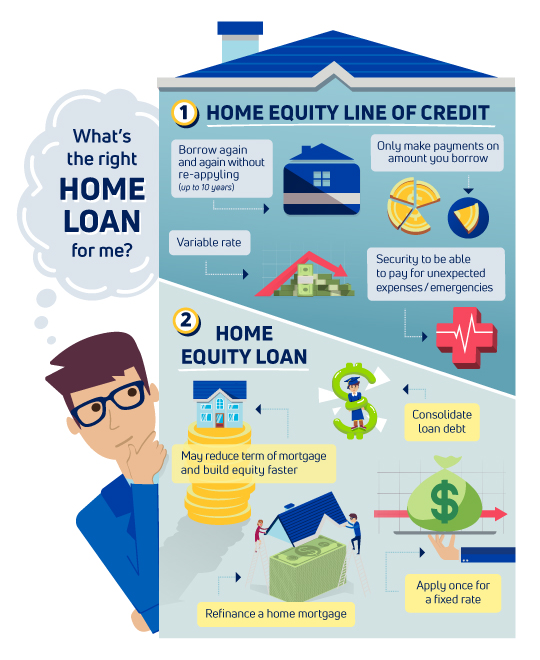Table Of Content

The lender’s average closing time is between 30 to 45 days, which is about the industry average. Bank branch, have equity in your home that does not exceed the loan-to-value (LTV) ratio of 80% and have good credit, you may qualify for a home equity loan. You should be prepared to provide an estimate of your home’s value as well as other supporting documents. A large one-time expense can be difficult to cover from savings alone. A home equity loan can be one of the most affordable ways to fund a large expense while sticking to a fixed amount.
Third Federal Savings and Loan: Best home equity loan lender for customer service
A home equity line of credit (HELOC) is a revolving line of credit, usually with an adjustable interest rate, which allows you to borrow up to a certain amount over a period of time. HELOCs work like credit cards, where you can continuously borrow up to an approved limit while paying off the balance. Loan TermsThe APR quoted is for a loan terms of 15 years and a minimum borrowing of $5,000, but terms can be as short as five years. There are closing costs, however, which can range from $175 to $2,000.
Are home equity loans tax deductible?
When does a home equity loan make sense? - CBS News
When does a home equity loan make sense?.
Posted: Tue, 16 Apr 2024 07:00:00 GMT [source]
BMO Harris offers the highest discounts on home equity loan rates of any lender we reviewed. You can check rates online, browse detailed information about loan programs and even watch mortgage-related videos on their website. There’s also an online application and a guide to help you through the process. Navy Federal Credit Union is the only lender we reviewed that allows qualified homeowners to borrow up to 100% of their home’s value. Military borrowers may be eligible for extra discounts and a streamlined approval process. Customer support can be contacted online, by phone or even on X (formerly Twitter).
Step 2: Calculate Your Debt-To-Income Ratio
The period when you can spend money through your HELOC is called the draw period. After the draw period ends, you can longer access the credit, and you enter your repayment period. With a HELOC, you’ll have access to a revolving credit line that you can repeatedly draw on and pay off. This provides more flexibility, which might be a plus if you have multiple expenses to cover.
The interest rate on a home equity loan—although higher than that of a first mortgage—is much lower than that of credit cards and other consumer loans. That helps explain why a primary reason that consumers borrow against the value of their homes via a fixed-rate home equity loan is to pay off credit card balances. When you’re shopping for a home equity loan, it’s smart to make sure your financials are in as good a shape as possible.
Home Equity Line of Credit (HELOC)
A home equity loan can also be effective in consolidating your debts, where you can often convert your current debt into a stable monthly loan payment, often at a lower interest rate. In general, lenders will approve loaning up to a maximum of 80% to 85% of your combined loan-to-value (CLTV) ratio. When you sell your home, the investor gets its money back, adjusted up or down by a share of the change in your home’s value. Depending on the investor, you’ll typically have up to 10 years, 30 years or a lifetime to exit the agreement.
The rates shown above are calculated using a loan or line amount of $30,000, with a FICO score of 700 and a combined loan-to-value ratio of 80 percent. → Cash-out refinance rates are usually lower than home equity loan interest rates. A home equity loan is a second mortgage that converts your home equity into cash. Home equity is the difference between how much your home is worth and the amount you owe on your outstanding mortgage balance. To determine how much you may be able to borrow with a home equity loan, divide your mortgage’s outstanding balance by your current home value.
The borrower will then pay off the fixed-rate amount over a specific period of time. Be sure to do your due diligence on this option because lenders may have different rules about how you can use it. When a homeowner takes out a home equity loan, the lender issues the entire loan at once and it is subject to a fixed interest rate. As with other traditional loans, the borrower must make monthly interest payments on the entire loan amount for a loan term of between five and 30 years. Consider a home equity loan if you’re facing a large home improvement project, wedding, medical bill or other one-time expense.
Home Equity Loan vs. Cash-Out Refinance (2024 Guide) - MarketWatch
Home Equity Loan vs. Cash-Out Refinance (2024 Guide).
Posted: Wed, 03 Apr 2024 07:00:00 GMT [source]
U.S. Bank (also known as U.S. Bancorp) is one of the largest banking institutions in the United States. Founded in 1863 as the United State National Bank of Portland, it’s now headquartered in Minneapolis, MN. Along with home equity loans, it offers a wide array of personal financial products, as well as business banking and wealth management services. The interest charged is now deductible only if the loan is used to “buy, build or substantially improve” the home that is collateral for that loan. If the loan is used for those purposes, then a taxpayer can deduct interest on up to $750,000 of borrowing.
Use our rate and payment calculator to find out what your home equity monthly payment may be. When mortgage rates were at historic lows, cash-out refinances were a no-brainer. A homeowner could tap equity in their home while locking in a rock-bottom mortgage rate. But now that mortgage rates have risen, a cash-out refi no longer seems like the best answer. Getting a home equity loan instead — a simpler, if slightly more expensive type of financing — might be the better choice.
This type of home loan is the most structured, and it mirrors a primary mortgage. However, a home equity loan typically has a slightly higher interest rate than a primary mortgage. That’s because the primary lender is the first to be repaid through sale proceeds if the home is foreclosed—so the home equity lender has added risk. Because you can draw on the line as necessary, HELOCs can be a better option if you don’t know exactly how much you need.

If you are unable to pay back the loan, you may lose your home to foreclosure. Obtaining a home equity loan is quite simple for many consumers because it is a secured debt. The lender runs a credit check and orders an appraisal of your home to determine your creditworthiness and the CLTV. A home equity loan generally allows you to borrow around 80% to 85% of your home’s value, minus what you owe on your mortgage. Some lenders allow you to borrow significantly more — even as much as 100% in some instances.
Exiting means selling your home, refinancing it or tapping your savings to repay the investor based on your home’s value at that time. The best home equity loan lenders excelled in areas that are historically important for this group, including speed, low lender fees and low home equity interest rates. Forbes Advisor reviewed 12 home equity loan lenders that do business both online and in person throughout the United States. The lenders we reviewed represent some of the largest home equity loan lenders by volume, which include banks, credit unions and online lenders. Credit RequirementsBorrowers must have a minimum credit score of 620. One of the major advantages of tapping your home equity compared to other financing options is the sheer amount of money you can potentially access.

No comments:
Post a Comment